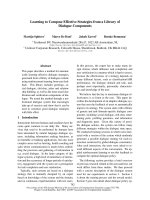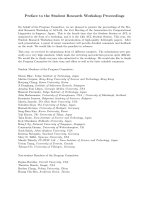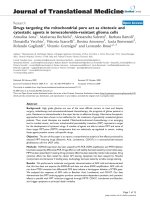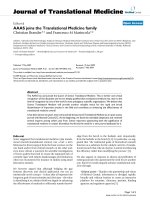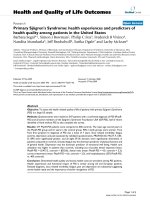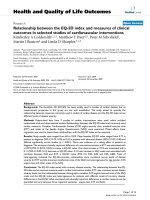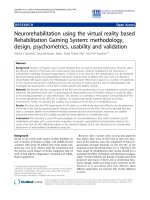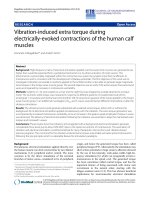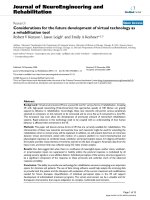báo cáo hóa học: " Introduction to the special issue from the proceedings of the 2006 International Workshop on Virtual Reality in Rehabilitation" ppt
Bạn đang xem bản rút gọn của tài liệu. Xem và tải ngay bản đầy đủ của tài liệu tại đây (174.75 KB, 2 trang )
BioMed Central
Page 1 of 2
(page number not for citation purposes)
Journal of NeuroEngineering and
Rehabilitation
Open Access
Commentary
Introduction to the special issue from the proceedings of the 2006
International Workshop on Virtual Reality in Rehabilitation
Emily A Keshner*
1,2
and Patrice (Tamar) Weiss
3
Address:
1
Dept. of Physical Therapy, College of Health Professions, Temple University, Jones Hall 600, 3307 Broad St., Philadelphia, PA 19140,
USA,
2
Dept. of Electrical and Computer Engineering, College of Engineering, Temple University, 1947 North 12th St., Philadelphia, PA 19122,
USA and
3
Laboratory for Innovations in Rehabilitation Research, Dept. of Occupational Therapy, Faculty of Social Welfare & Health Sciences,
University of Haifa, Mount Carmel, Haifa 31905, Israel
Email: Emily A Keshner* - ; Patrice (Tamar) Weiss -
* Corresponding author
Abstract
New technologies are rapidly having a great impact on the development of novel rehabilitation
interventions. One of the more popular of these technological advances is virtual reality. The wide
range of applications of this technology, from immersive environments to tele-rehabilitation
equipment and care, lends versatility to its use as a rehabilitation intervention. But increasing access
to this technology requires that we further our understanding about its impact on a performer. The
International Workshop on Virtual Reality in Rehabilitation (IWVR), now known as Virtual
Rehabilitation 2007, is a conference that emerged from the need to discover how virtual reality
could be applied to rehabilitation practice. Individuals from multiple disciplines concerned with the
development, transmission, and evaluation of virtual reality as a technology applied to rehabilitation
attend this meeting to share their work. In this special issue of the Journal of NeuroEngineering and
Rehabilitation we are sharing some of the papers presented at the 2006 meeting of IWVR with the
objective of offering a description of the state of the art in this research field. A perusal of these
papers will provide a good cross-section of the emerging work in this area as well as inform the
reader about new findings relevant to research and practice in rehabilitation.
Background
The most influential change in physical rehabilitation
practice over the past decade has been the vast develop-
ment of new technologies that enable clinicians to pro-
vide a greater variety of therapeutic interventions. Virtual
reality is fast becoming one of the more popular of these
new technologies. Reasons for its popularity include its
potential for providing safe and functional environments
that can be adapted to meet the needs of diverse therapeu-
tic objectives.
The International Workshop on Virtual Reality in Rehabil-
itation (IWVR) is a conference that emerged from the need
for the disciplines concerned with the development, trans-
mission, and evaluation of virtual reality as a technology
applied to physical rehabilitation to have an opportunity
to educate and learn from each other. Improvements in
technology depend on interdisciplinary cooperation
among neuroscientists, engineers, computer program-
mers, psychologists, and rehabilitation specialists, and on
adoption and widespread application of objective criteria
for evaluating alternative methods [1]. If technology
transfer is to become successful, we need to establish col-
Published: 6 June 2007
Journal of NeuroEngineering and Rehabilitation 2007, 4:18 doi:10.1186/1743-0003-4-18
Received: 30 April 2007
Accepted: 6 June 2007
This article is available from: />© 2007 Keshner and Weiss; licensee BioMed Central Ltd.
This is an Open Access article distributed under the terms of the Creative Commons Attribution License ( />),
which permits unrestricted use, distribution, and reproduction in any medium, provided the original work is properly cited.
Publish with BioMed Central and every
scientist can read your work free of charge
"BioMed Central will be the most significant development for
disseminating the results of biomedical research in our lifetime."
Sir Paul Nurse, Cancer Research UK
Your research papers will be:
available free of charge to the entire biomedical community
peer reviewed and published immediately upon acceptance
cited in PubMed and archived on PubMed Central
yours — you keep the copyright
Submit your manuscript here:
/>BioMedcentral
Journal of NeuroEngineering and Rehabilitation 2007, 4:18 />Page 2 of 2
(page number not for citation purposes)
laborative interactions in which the engineers, clinical sci-
entists, and clinicians are comfortable with the language
of each respective discipline, and in which the goals for
each discipline becomes overlapping with the skills and
goals of the other fields of endeavor and of the consumer
[2]. Such interdisciplinary interactions are demonstrated
in the work presented in most of the papers contained in
this special issue of the Journal of NeuroEngineering and
Rehabilitation. One glance at the academic affiliations of
the authors of these papers will reveal how important
multidisciplinary input is in order to make these new
technologies relevant to the problems encountered in
rehabilitation.
Virtual reality as a treatment intervention
The four full papers and five short communications
included in this issue span a wide range of clinical areas
that can be impacted by virtual reality. Several of these
papers have demonstrated that a virtual reality interven-
tion can produce a significant clinical impact. Bugnariu
and Fung describe the results of a study on the effects of
unanticipated visual feedback on aging, and the capability
of the central nervous system to select pertinent sensory
information after repeated exposure to sensory conflicts
created by VR.
Lamontagne, Fung, McFadyen and Faubert used a virtual
environment to investigate how perception of optic flow
speed influenced the walking speed of patients who have
had a stroke. Stewart, Yeh, Jung, Yoon, Whitford, Chen, Li,
McLaughlin, Rizzo, and Winstein describe four novel VR
tasks that were developed and tested to improve arm and
hand movement skills in individuals with hemiparesis.
Subramanian, Knaut, Beaudoin, McFadyen, Feldman and
Levin describe an immersive and interactive experimental
protocol developed in a virtual reality environment and
designed to provide feedback about performance and
quality of pointing movements to patients with motor
disorders.
Virtual reality as a evaluative tool
Virtual reality has also been explored as a tool to assess
disability. Keshner, Streepey, Dhaher, and Hain used a vir-
tual environment to measure the combined effect of vis-
ual and physical disturbances on postural response
kinematics, and found that responses of individuals with
visual sensitivity could be distinguished by their diagnos-
tic histories. Morganti, Gaggioli, Strambi, Rusconi and
Riva present an integrated evaluation method in which
neuropsychological spatial ability evaluation is extended
with more situational computer based tools that allow the
assessment of spatial orientation during the interaction
with complex 3D environments.
Future directions
Another paper has focused on further developing the tech-
nology to make it more versatile. Oddsson, Karlsson, Kon-
rad, Ince, Williams, and Zemkova present the design of a
new portable device that was an extension of their
research on making the protocol of partial body weight
support during treadmill walking more functional by add-
ing a virtual environment that stimulated associated pos-
tural adjustments.
Finally, two papers present very preliminary data that hint
at the tremendous potential of this versatile technology
for new areas of rehabilitation research. Baheux,
Yoshizawa, and Yoshida have designed a virtual environ-
ment to simulate hemispatial neglect with the aim of pro-
viding a more precise diagnostic tool. Dvorkin, Kenyon,
and Keshner shifted the orientation of both the central
and peripheral visual fields in a virtual visual environ-
ment to determine how changes in visuo-spatial relations
alter motor planning during reaching.
Conclusion
This collection of papers provides an up-to-date descrip-
tion of the state of the art in the field of virtual reality as
applied to rehabilitation. The field is rapidly advancing
and numerous research groups have already demon-
strated applications of great clinical relevance. It is our
hope that the papers in this issue will not only educate the
readers about the current state of research with virtual
reality, but also generate new ideas that promote rehabil-
itation research and application using new technologies
like virtual reality.
References
1. Vaughan TM, Heetderks WJ, Trejo LJ, Rymer WZ, Weinrich M,
Moore MM, Kubler A, Dobkin BH, Birbaumer N, Donchin E, Wolpaw
EW, Wolpaw JR: Brain-computer interface technology: a
review of the Second International Meeting. IEEE Trans Neural
Syst Rehabil Eng 2003, 11:94-109.
2. Hammel J: Technology and the environment: supportive
resource or barrier for people with developmental disabili-
ties? Nurs Clin North Am 2003, 38:331-49.
